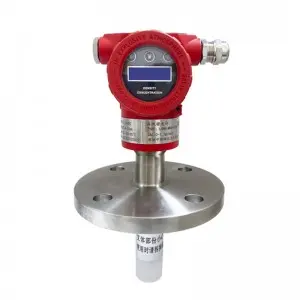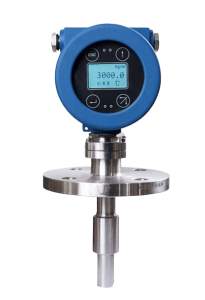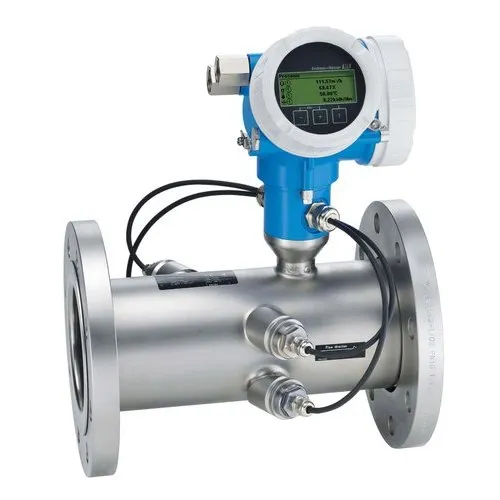Inline Density Meter
Traditional density meters include the following five types: tuning fork density meters, Coriolis density meters, differential pressure density meters, radioisotope density meters, and ultrasonic density meters. Let's dive into pros and cons of those online density meters.
1. Tuning fork density meter
The tuning fork density meter works following the principle of vibration. This vibrating element is similar to a two-tooth tuning fork. The fork body vibrates due to a piezoelectric crystal located at the root of the tooth. The frequency of the vibration is detected by another piezoelectric crystal.
Through the phase shift and amplification circuit, the fork body vibrates at the natural resonant frequency. When the liquid flows through the fork body, the resonant frequency changes with the corresponding vibration, so that the accurate density is calculated by the electronic processing unit.
| Advantages | Disadvantages |
| The plug-n-play density meter is easy to install without bothering to maintenance. It can measure the density of a mixture containing solids or bubbles. | The density meter falls to perform perfectly when used to measure the media that they are prone to crystallize and scale. |
Typical Applications
In general, the tuning fork density meter is often used in petrochemical, food and brewing, pharmaceutical, organic and inorganic chemical industry, as well as mineral processing (such as clay, carbonate, silicate, etc.). It is mainly used for interface detection in multi-product pipelines in the above industries, such as wort concentration (brewery), acid-base concentration control, sugar refining concentration and density detection of stirred mixtures. It also could be used to detect the reactor endpoint and separator interface.
2. Coriolis Online Density Meter
The Coriolis density meter works through measuring the resonance frequency to get accurate density passing through pipes. The measuring tube vibrates at a certain resonant frequency consistently. The vibration frequency changes with the density of the fluid. Therefore, the resonant frequency is a function of the fluid density. In addition, the mass flow within a confined pipeline is able to measure on the basis of Coriolis principle directly.
| Advantages | Disadvantages |
| The Coriolis inline density meter is able to get three readings of mass flow, density and temperature at the same time. It also outstands among other density meters by the virtue of accuracy and reliability. | The price is relatively high compared with other density meters. It's prone to be worn and clogged when used to measure granular media. |
Typical applications
In the petrochemical industry, it makes extensive use in petroleum, oil refining, oil blending, and oil-water interface detection; it's inevitable to monitor and control density of soft drinks like grape, tomato juices, fructose syrup as well as edible oil in automatic processing of beverage. Except for above application in food and beverage industry, it's useful in processing of dairy products, controlling alcohol content in winemaking.
In industrial processing, it is useful in density testing of black pulp, green pulp, white pulp, and alkaline solution, chemical urea, detergents, ethylene glycol, acid-base, and polymer. It can also be used in mining brine, potash, natural gas, lubricating oil, biopharmaceuticals, and other industries.

Tunning Fork Density Meter

Coriolis Density Meter
3. Differential Pressure Density Meter
A differential pressure density meter (DP density meter) utilizes the difference in pressure across a sensor to measure the density of a fluid. It takes effects on the principle that a fluid density could be obtained by measuring the pressure difference between two points.
| Advantages | Disadvantages |
| The differential pressure density meter is a simple, practical, and cost-effective product. | It's junior to other density meters for large errors and unstable readings. It needs to be installed up to rigorous verticality requirements. |
Typical applications
Sugar and wine industry: extracting juice, syrup, grape juice, etc., alcohol GL degree, ethane ethanol interface, etc.;
Dairy industry: condensed milk, lactose, cheese, dry cheese, lactic acid, etc.;
Mining: coal, potash, brine, phosphate, this compound, limestone, copper, etc.;
Oil refining: lubricating oil, aromatics, fuel oil, vegetable oil, etc.;
Food processing: tomato juice, fruit juice, vegetable oil, starch milk, jam, etc.;
Pulp and paper industry: black pulp, green pulp, pulp washing, evaporator, white pulp, caustic soda, etc.;
Chemical industry: acid, caustic soda, urea, detergent, polymer density, ethylene glycol, sodium chloride, sodium hydroxide, etc.;
Petrochemical industry: natural gas, oil and gas water washing, kerosene, lubricating oil, oil/water interface.

Ultrasonic Density Meter
IV. Radioisotope Density Meter
The radioisotope density meter is equipped with a radioisotope radiation source. Its radioactive radiation (such as gamma rays) is received by the radiation detector after passing through a certain thickness of the measured medium. The attenuation of the radiation is the function of the density of the medium, as the thickness of the medium is constant. The density can be obtained through the internal calculation of the instrument.
| Advantages | Disadvantages |
| The radioactive density meter can measure parameters such as the density of the material in the container without direct contact with the object being measured, especially in high temperature, pressure, corrosiveness and toxicity. | Scaling and wearing on the inner wall of the pipeline will cause measurement errors, the approval procedures are cumbersome while the management and inspection are strict. |
It widely used in petrochemical and chemical, steel, building materials, nonferrous metals and other industrial and mining enterprises to detect the density of liquids, solids (such as gas-borne coal powder), ore slurry, cement slurry and other materials.
Applicable to the online requirements of industrial and mining enterprises, especially for the measurement of density under complex and harsh working conditions such as rough and hard, highly corrosive, high temperature and high pressure.
V. Ultrasonic Density/Concentration Meter
Ultrasonic density/concentration meter measures the density of liquid based on the transmission speed of ultrasonic waves in liquid. It has been proved that the transmission speed is constant with specific density or concentration at a certain temperature. The changes in density and concentration of liquids have effects on the corresponding transmission speed of ultrasonic wave.
The transmission speed of ultrasound in liquid is the function of the elastic modulus and density of the liquid. Therefore, the difference in the transmission speed of ultrasound in the liquid at a certain temperature means the corresponding change in the concentration or density. With the above parameters and current temperature, the density and concentration could be calculated.
| Advantages | Disadvantages |
| Ultrasonic detection is independent of the turbidity, color and conductivity of the medium, nor the flow state and impurities. | The price of this product is relatively high, and the output is easily deviated for bubbles in measurement. Restrictions from circuit and harsh environments on site also influence the precision of readings. The accuracy of this product needs to be improved, too. |
Typical applications
It's applicable to chemical, petrochemical, textile, semiconductor, steel, food, beverage, pharmaceutical, winery, papermaking, environmental protection and other industries. It is mainly used to measure the concentration or density of the following media and conduct related monitoring and control: acids, alkalis, salts; chemical raw materials and various oil products; fruit juices, syrups, beverages, wort; various alcoholic beverages and raw materials for making alcoholic beverages; various additives; oil and material transportation switching; oil-water separation and measurement; and monitoring of various main and auxiliary material components.
Post time: Dec-20-2024





